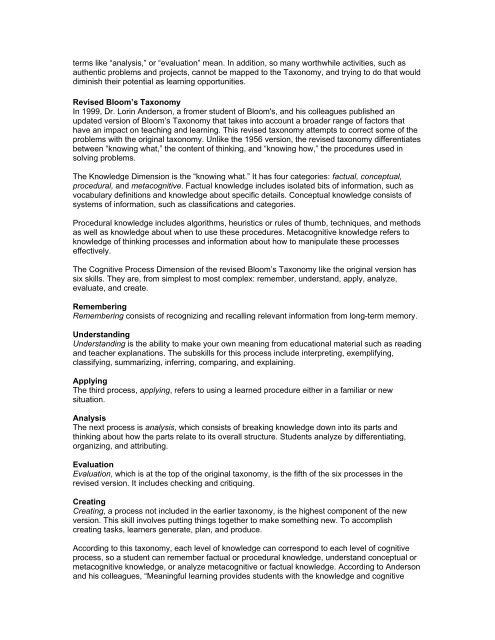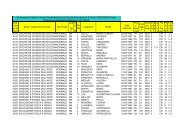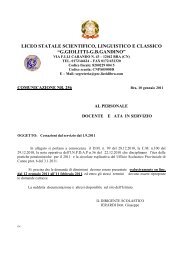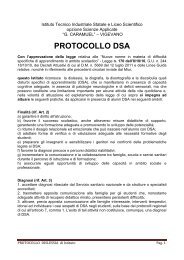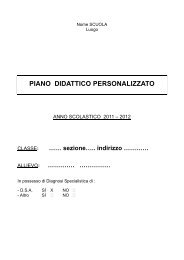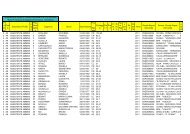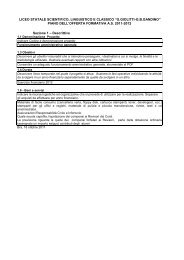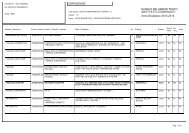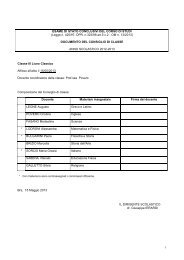Bloom's Taxonomy: Categories in the Cognitive ... - Licei di Bra
Bloom's Taxonomy: Categories in the Cognitive ... - Licei di Bra
Bloom's Taxonomy: Categories in the Cognitive ... - Licei di Bra
Create successful ePaper yourself
Turn your PDF publications into a flip-book with our unique Google optimized e-Paper software.
terms like “analysis,” or “evaluation” mean. In ad<strong>di</strong>tion, so many worthwhile activities, such asau<strong>the</strong>ntic problems and projects, cannot be mapped to <strong>the</strong> <strong>Taxonomy</strong>, and try<strong>in</strong>g to do that would<strong>di</strong>m<strong>in</strong>ish <strong>the</strong>ir potential as learn<strong>in</strong>g opportunities.Revised Bloom’s <strong>Taxonomy</strong>In 1999, Dr. Lor<strong>in</strong> Anderson, a fromer student of <strong>Bloom's</strong>, and his colleagues published anupdated version of Bloom’s <strong>Taxonomy</strong> that takes <strong>in</strong>to account a broader range of factors thathave an impact on teach<strong>in</strong>g and learn<strong>in</strong>g. This revised taxonomy attempts to correct some of <strong>the</strong>problems with <strong>the</strong> orig<strong>in</strong>al taxonomy. Unlike <strong>the</strong> 1956 version, <strong>the</strong> revised taxonomy <strong>di</strong>fferentiatesbetween “know<strong>in</strong>g what,” <strong>the</strong> content of th<strong>in</strong>k<strong>in</strong>g, and “know<strong>in</strong>g how,” <strong>the</strong> procedures used <strong>in</strong>solv<strong>in</strong>g problems.The Knowledge Dimension is <strong>the</strong> “know<strong>in</strong>g what.” It has four categories: factual, conceptual,procedural, and metacognitive. Factual knowledge <strong>in</strong>cludes isolated bits of <strong>in</strong>formation, such asvocabulary def<strong>in</strong>itions and knowledge about specific details. Conceptual knowledge consists ofsystems of <strong>in</strong>formation, such as classifications and categories.Procedural knowledge <strong>in</strong>cludes algorithms, heuristics or rules of thumb, techniques, and methodsas well as knowledge about when to use <strong>the</strong>se procedures. Metacognitive knowledge refers toknowledge of th<strong>in</strong>k<strong>in</strong>g processes and <strong>in</strong>formation about how to manipulate <strong>the</strong>se processeseffectively.The <strong>Cognitive</strong> Process Dimension of <strong>the</strong> revised Bloom’s <strong>Taxonomy</strong> like <strong>the</strong> orig<strong>in</strong>al version hassix skills. They are, from simplest to most complex: remember, understand, apply, analyze,evaluate, and create.Remember<strong>in</strong>gRemember<strong>in</strong>g consists of recogniz<strong>in</strong>g and recall<strong>in</strong>g relevant <strong>in</strong>formation from long-term memory.Understand<strong>in</strong>gUnderstand<strong>in</strong>g is <strong>the</strong> ability to make your own mean<strong>in</strong>g from educational material such as read<strong>in</strong>gand teacher explanations. The subskills for this process <strong>in</strong>clude <strong>in</strong>terpret<strong>in</strong>g, exemplify<strong>in</strong>g,classify<strong>in</strong>g, summariz<strong>in</strong>g, <strong>in</strong>ferr<strong>in</strong>g, compar<strong>in</strong>g, and expla<strong>in</strong><strong>in</strong>g.Apply<strong>in</strong>gThe third process, apply<strong>in</strong>g, refers to us<strong>in</strong>g a learned procedure ei<strong>the</strong>r <strong>in</strong> a familiar or newsituation.AnalysisThe next process is analysis, which consists of break<strong>in</strong>g knowledge down <strong>in</strong>to its parts andth<strong>in</strong>k<strong>in</strong>g about how <strong>the</strong> parts relate to its overall structure. Students analyze by <strong>di</strong>fferentiat<strong>in</strong>g,organiz<strong>in</strong>g, and attribut<strong>in</strong>g.EvaluationEvaluation, which is at <strong>the</strong> top of <strong>the</strong> orig<strong>in</strong>al taxonomy, is <strong>the</strong> fifth of <strong>the</strong> six processes <strong>in</strong> <strong>the</strong>revised version. It <strong>in</strong>cludes check<strong>in</strong>g and critiqu<strong>in</strong>g.Creat<strong>in</strong>gCreat<strong>in</strong>g, a process not <strong>in</strong>cluded <strong>in</strong> <strong>the</strong> earlier taxonomy, is <strong>the</strong> highest component of <strong>the</strong> newversion. This skill <strong>in</strong>volves putt<strong>in</strong>g th<strong>in</strong>gs toge<strong>the</strong>r to make someth<strong>in</strong>g new. To accomplishcreat<strong>in</strong>g tasks, learners generate, plan, and produce.Accord<strong>in</strong>g to this taxonomy, each level of knowledge can correspond to each level of cognitiveprocess, so a student can remember factual or procedural knowledge, understand conceptual ormetacognitive knowledge, or analyze metacognitive or factual knowledge. Accord<strong>in</strong>g to Andersonand his colleagues, “Mean<strong>in</strong>gful learn<strong>in</strong>g provides students with <strong>the</strong> knowledge and cognitive


